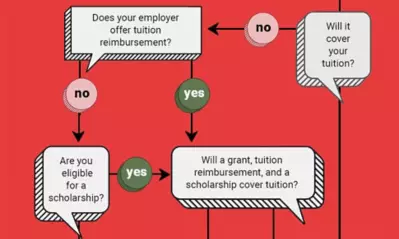How to help students with test anxiety

Written by Michael Feder

Reviewed by Pamela M. Roggeman, EdD, Dean, College of Education

Test anxiety is a real problem, affecting 25% to 40% of U.S. students. Anxiety, along with academic stress, can appear as physical symptoms (such as headaches, nausea and sleeplessness) and psycho-emotional symptoms (like difficulty concentrating or increased irritability).
While test anxiety is common, it’s important to make sure it’s not debilitating. Parents, guardians and educators can play an active role in supporting students experiencing these feelings. They can provide resources that teach relaxation techniques and testing strategies, or simply listen as students share their concerns. Here, we’ll explore eight ways educators can help ease test anxiety in students.
1. Emphasize preparation
Helping students who suffer from test anxiety starts with proper preparation. This means helping them study effectively and creating a clear plan for their testing day. Preparation can look different for individuals, but there are a few tips everyone can benefit from:
- Create an organized study plan: Develop a weekly or monthly testing schedule and provide students with study guides.
- Practice relaxation techniques: Help students learn how to calm themselves by practicing meditation, visualization, progressive muscle relaxation, diaphragmatic breathing, mindfulness or yoga.
- Get enough rest: Encourage students to go to bed early and take breaks while studying.
- Eat healthy meals: A balanced diet helps reduce stress levels and improve alertness and readiness for testing.
- Seek more resources: These include everything from testing strategies to test-taking skills.
2. Try to understand their fears
Test anxiety can be rooted in a number of underlying fears, such as:
- The fear of failure or not being good enough
- Past trauma related to school or test-taking
- Depression or other mental health issues
- Performance anxiety and social comparison
Try to understand why your student is feeling anxious or scared about testing. Ask questions about past testing experience, what triggers their stress and how they feel when testing. For example:
- What do you think makes testing so difficult for you?
- Tell me about a time when you didn’t do well on a test. How did you feel? What happened?
- Do any particular thoughts come to mind when testing?
- What are your biggest concerns about testing?
As the student’s feelings and fears become clearer, you can offer more targeted and practical support, and you can discuss strategies and resources to help address these issues and succeed in learning, both online and in the classroom.
3. Provide opportunities to demonstrate competency
It can be challenging for those who experience testing anxiety to feel they are seen and heard, so it’s crucial to give them an opportunity to prove their competency. This could mean providing them with additional testing time or a relaxed testing environment. You could also offer constructive feedback on their testing performance and encouragement to keep trying.
Additionally, you can provide extra testing resources such as practice tests or test-taking strategies. This way, students can achieve tangible results and understand success is possible with the right support.
4. Reframe their perspective
To help students maintain a better perspective on testing, explain that testing is only one part of the learning journey. Remind them to take a step back and focus on the bigger picture. The testing process has many moving parts, and it’s essential to help students see that testing is not the only way to measure their intelligence or abilities.
Encourage them to explore other opportunities such as:
- Internships
- Mentorship programs
- Extracurricular activities
These experiences can give students a wider perspective on how intelligence and competency are assessed as well as provide them with alternative paths to success. Likewise, a broader perspective can help build self-confidence and resilience, which can, in turn, help reduce testing anxiety.
5. Help manage underlying stress
Test anxiety is often caused or exacerbated by preexisting anxiety. Approximately 31.9% of adolescents reported having an active form of the condition, with 8.3% experiencing extreme levels that meet the DSM-IV criteria for impairment. Therefore, helping students address and manage underlying stress in both the short and long term can be helpful.
Not every condition is the same, but some ideas for helping students manage their stress include:
- Creating a welcoming classroom environment by encouraging open communication and support.
- Teaching relaxation techniques, such as mindfulness, deep breathing or visualization to help manage anxiety.
- Encouraging students to take regular breaks throughout the testing process.
By doing this, you can help students feel more secure in their testing environment and better manage their testing anxiety overall.
6. Share effective test-taking strategies
Test-taking strategies are specific tools, techniques and approaches that can be used to maximize performance, reduce stress and improve confidence. Examples of effective test-taking strategies include:
- Planning ahead: Students must learn how to allocate time, understand the test format and preview testing material to anticipate which questions may be asked.
- Reading directions: It’s important to carefully read instructions to ensure comprehension before beginning any testing activity.
- Staying focused: Remaining organized and on task during testing can help a student avoid wasting time or needing to double-check answers.
- Eliminating distractions: Staying focused by turning off electronics, putting away testing materials and blocking out other test-takers can help students do their best work while managing their time efficiently.
7. Emphasize positive thinking
One of the best ways to help students manage testing anxiety is by encouraging positive thinking. Positive thinking can be a powerful tool for believing in one’s ability to succeed and perform well on testing days. Positive thinking can also help reduce stress levels, preventing testing anxiety from spiraling out of control.
Positive thinking takes practice, and building healthy habits can create a framework to achieve that. Help your students develop concrete examples of positive self-talk they can use on testing days, such as, “I am capable and confident,” or, “I can do this!” Have students write these affirmations and commit them to memory.
Other ways to encourage positive thinking include:
- Rewarding positive testing behavior
- Taking moments of silence to relax and refocus
- Reinforcing testing successes instead of failures
8. Encourage them to get enough sleep
Getting a good night’s sleep before a testing day is one of the best ways to reduce stress and maximize performance. Sleep helps restore energy levels, dispel mental fog and improve memory.
The American Academy of Sleep Medicine recommends that children ages 6 to 12 get 9 to 12 hours of sleep every 24 hours and youths ages 13 to 18 get 8 to 10 hours.
Here are some ways to optimize sleep before testing:
- Go to bed and wake up at the same time every night.
- Avoid bright screens (TV, computer, phone) for at least one hour before bed.
- Avoid caffeine or other stimulants late in the day.
- Listen to calming music or read something relaxing before turning out the lights.
- Practice mindful breathing or visualization techniques to feel more relaxed.
Explore online education programs at Unviersity of Phoenix
Reducing text anxiety is just one part of finding success in the classroom. Explore educational degrees and certificates at University of Phoenix for more strategies and techniques!
- Bachelor of Science in Education/Early Childhood Education — This program teaches curriculum planning, instructional practice, student engagement and other valuable educational skills.
- Bachelor of Science in Education/Elementary Education — If you’re eager to learn skills geared toward teaching at the elementary school level, this online bachelor's in elementary education will help build teaching and leadership skills, learning strategies and more.
- Online Master's in Special Education — This Master of Arts in Education/Special Education helps cultivate strategies for teaching students with disabilities and creating individualized learning plans. Other skills taught are curriculum development and differentiated instruction.
- Continuing education for teachers — Organized by course topic and searchable by state, continuing education courses cover topics ranging from math to gifted education.
- Education certificates — From alternative licensure to post-master’s skill development, University of Phoenix’s certificate programs are designed to bolster your skill set in your desired field of interest.
Learn more about online education degrees and certificates through University of Phoenix.
Read more articles like this:

ABOUT THE AUTHOR
A graduate of Johns Hopkins University and its Writing Seminars program and winner of the Stephen A. Dixon Literary Prize, Michael Feder brings an eye for detail and a passion for research to every article he writes. His academic and professional background includes experience in marketing, content development, script writing and SEO. Today, he works as a multimedia specialist at University of Phoenix where he covers a variety of topics ranging from healthcare to IT.

ABOUT THE REVIEWER
As dean of the University of Phoenix College of Education, Pamela Roggeman has spent over a decade in higher education teacher preparation in both the public and private sector. Her experience has included national partnerships that help to advance thought leadership in the field of education. Dr. Roggeman also serves as the President of the Arizona Educational Foundation’s Board of Directors.
This article has been vetted by University of Phoenix's editorial advisory committee.
Read more about our editorial process.


